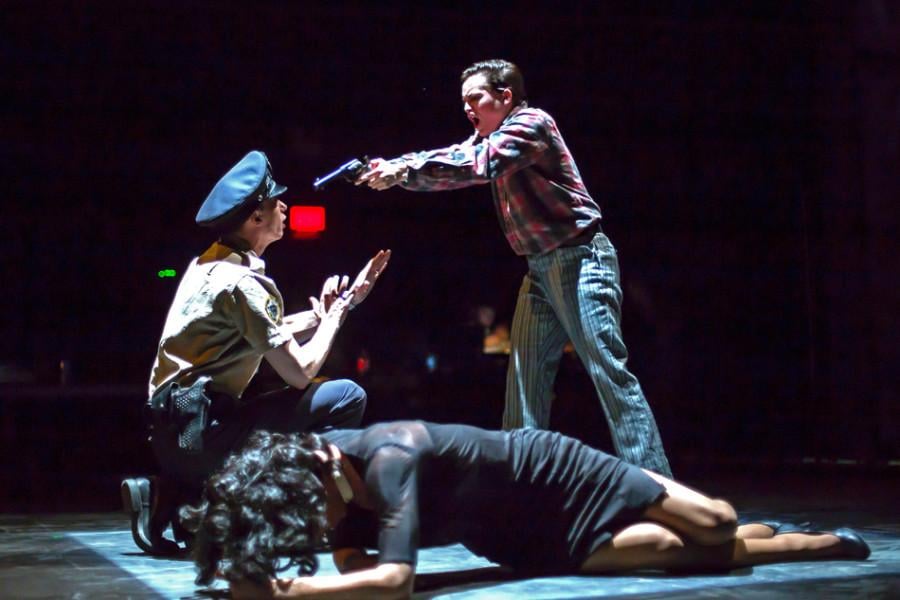‘Hit the Wall’ brings the start of modern gay rights movement to stage
Zack Laurence/The Daily Northwestern
“Hit the Wall,” a play based on the Stonewall Riots of 1969, opens Friday for a three-day run at the Wallis Theater.
April 15, 2015
A&E
The riot that served as the impetus of the modern gay rights movement is coming to a Northwestern stage.
“Hit the Wall,” a play based on the Stonewall Riots of 1969, opens Friday for a three-day run at the Wallis Theater.
The play is set at the Stonewall Inn, an underground gay bar in Greenwich Village, New York, where a routine police raid breaks into a full-scale three-day riot. Issues such as LGBT rights, racial tensions and police brutality are present throughout the show.
“(Hit the Wall) deals with a lot of issues that we’re still dealing with now,” director Gina Hayes said. “That’s why I picked it originally.”
The play is part of NU’s Masters of Fine Arts Lab Series, in which student directors and designers from the MFA program are matched and have the freedom to create their own productions of contemporary plays.
Hayes said she first saw “Hit the Wall” at The Greenhouse Theater Center in Chicago.
She said it resonated with her because she was grappling with issues about her own sexuality at the time and was just about to come out publicly as bisexual.
“I got very emotionally attached to the play and what it was trying to say,” the second-year MFA student said. “I didn’t really realize before I saw it the real extent of why we march in pride parades and the beginning of the gay rights movement.”
Communication senior Brannon Bowers, one of the actors, said the play tells an important and unique story.
“It has such great characters that don’t succumb to stereotypes, but are really their own people,” he said. “(It shows) a spectrum of gay characters which you never get to see in other works.”
Bowers said the cast worked with a dramaturg who taught them about the New York politics in 1969 and the different groups in the gay liberation movement.
“There was a lot of dramaturgy work to get into the mindset of being in this specific time period because it’s completely different from what we see now,” he said. “There were very strict laws about being gay and you could be arrested.”
Stylistically, the play will be different from the production at The Greenhouse, Hayes said. She incorporated some dance elements into the riot scenes to make the play her own.
“I have a real interest in dance and I come from a little bit of a dance background, so my riot is much more stylized than the riot that was staged,” she said. “That was much more visceral, people rushing through the space.”
The choreography tries to capture many emotions that cannot be expressed in words and will be “both jarring and exciting to watch” at the same time, said Communication senior Frankie Bennett, an actor in the play.
Another notable difference in Hayes’s version of “Hit the Wall” is that it will be performed in an alley configuration. Audience members will sit on opposite sides of the stage, as opposed to a “three-quarter thrust” configuration in which audience members sit on three sides.
“It’s an interesting way to use the space,” Bennett said. “You get to see (the play) from all angles.”
Bowers said he is looking forward to seeing the audience react to playwright Ike Holter’s script.
“It’s sassy, it’s smart, it’s quick,” he said. “There’s a lot of banter back-and-forth and a lot of inventive name-calling. I’m really interested to see how the audience responds to some of those quick wits.”
But more than that, Bowers said he wants the audience to realize that the characters being portrayed still exist today and that the fight for LGBT equality is not yet over.
In the same vein, Bennett said he hopes people come away from the play wanting to start something and create change.
“I think that the real heart of ‘Hit the Wall’ is that change does not come easy and you just have to start changing to get what you need to get done,” Bennett said.
The first pride parade was held in 1970 — one year after the Stonewall riots.
“That’s why there’s a pride parade every single year in all of these different cities and countries across the world,” Hayes said. “This is the story of all the individual revolutionaries who came together and made that happen.”



